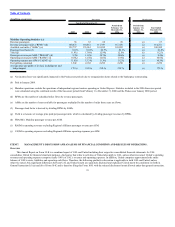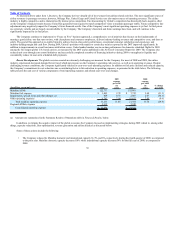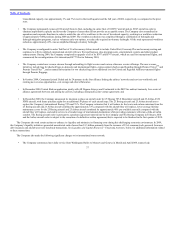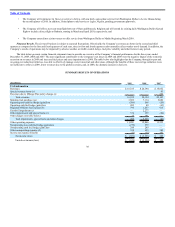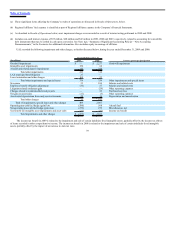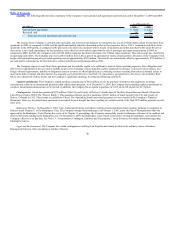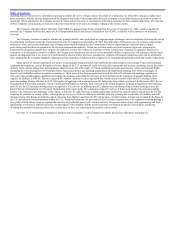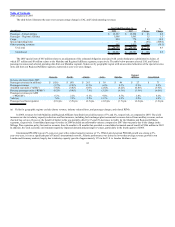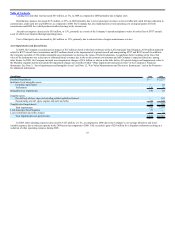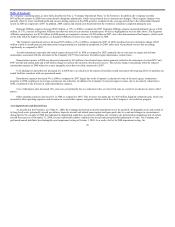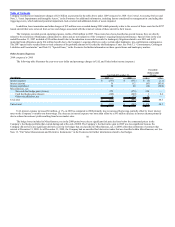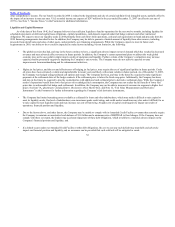United Airlines 2009 Annual Report Download - page 47
Download and view the complete annual report
Please find page 47 of the 2009 United Airlines annual report below. You can navigate through the pages in the report by either clicking on the pages listed below, or by using the keyword search tool below to find specific information within the annual report.
Table of Contents
In light of the current poor economic environment, these two factors—network composition and decline of premium and business demand—have had, and
may continue to have, a negative impact on our results of operations.
In 2009, revenues for both Mainline and Regional Affiliates were negatively impacted by yield decreases of 15% and 13%, respectively, as compared to
2008. The yield decreases were a result of the weak economic environment in 2009 and the economic factors discussed above. Mainline revenues were also
negatively impacted by lower RPMs, which were largely driven by the Company’s capacity reductions and by the severe global recession. Partially offsetting
Regional Affiliates’ decrease in yield was a 13% increase in RPMs, driven by an 11% increase in capacity. Regional Affiliates capacity increased as we adjusted
the size of our aircraft and capacity across United’s total network to conform to market demand and fulfill prior contractual commitments.
Although the impact of the global recession on the Company’s international network, as well as business and premium travel, during late 2008 and 2009
was severe, the Company saw indicators of economic recovery during the fourth quarter of 2009, which accelerated as the quarter progressed. While fourth
quarter 2009 consolidated passenger unit revenues were down 5.2% year-over-year, this performance was a vast improvement from the double digit declines in
prior quarters. Most importantly, there was a much needed sequential progress during the quarter, ending with modest growth in December. Signs of recovery
were evident internationally, as well as in premium cabin booking and corporate revenues.
In 2009, Mainline and Regional Affiliate revenues benefited from an increase in ancillary revenues, which includes bag fees and other unbundled services,
of approximately $141 million, compared to 2008. For the full year of 2009, ancillary revenues totaled approximately $1.1 billion.
Mainline and Regional Affiliate revenues were favorably impacted in 2009 by an adjustment of approximately $36 million related to certain tax accruals
that were previously recorded as a reduction of revenue. This adjustment was recorded as a result of new information received by the Company related to these
tax matters.
Cargo revenues declined by $318 million, or 37%, in 2009 as compared to 2008, due to four key factors. First, United took significant steps to rationalize
its capacity, with reduced international capacity affecting a number of key cargo markets. Second, as noted by industry statistical releases during 2009, virtually
all carriers in the industry, including United, were sharply impacted by reduced air freight and mail volumes driven by lower recessionary demand, with the
resulting oversupply of cargo capacity putting pressure on industry pricing in nearly all markets. Some of the largest industry demand reductions occurred in the
Pacific cargo market, where United has a greater cargo capacity as compared to the Atlantic, Latin and Domestic air cargo markets. Third, lower fuel costs in
2009 also reduced cargo revenues through lower fuel surcharges on cargo shipments as compared to 2008 when historically high fuel prices occurred. Finally
United, historically one of the largest carriers of U.S. international mail, was impacted by lower mail volumes and pricing beginning in third quarter of 2009
arising from U.S. international mail deregulation. The deregulation moved pricing from regulated rates set by the DOT to market-based pricing as a result of a
competitive bidding process. Towards the end of 2009, the Company began to experience significant market stabilization and improvement in cargo industry
demand and yields.
43




